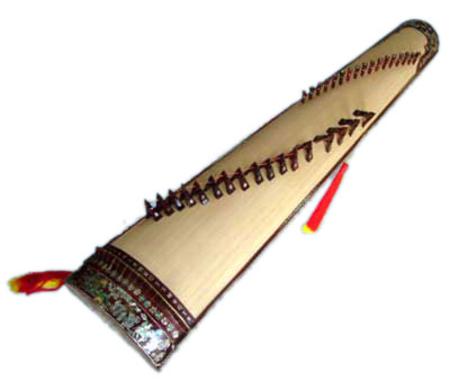The Vietnamese 16-chord zither is also known as Dan Thap Luc or sixteen-stringed zither. The Vietnamese 16-chord zither originates from the ancient capital city of Hue, where women once played it for royalty, and the instrument is still considered a symbol of the city.
Vietnamese 16-chord zither has a long-parallelepiped shape, resembles a bamboo tube that has been sliced vertically in half.. The frame of the instrument has trapezium-shape, 110-120 cm in length. The large end is 25-30 cm in width with holes and to hang the strings. The narrow is 15-20 cm in width with 16 tuning keys on the surface of the instrument. Its surface is made of wootung tree, 0.05 cm thick and arched.
Toward the middle of the sound board there are 16 bridges made of wood or bone tipped with copper for hanging the strings and movable to tune the pitches, thus creating various notes. At the narrower end of the box are sixteen pegs for tuning. The strings are made of metal with different sizes and tuned to the pentatonic scale.
The Vietnamese 16-chord zither sits flat like an autoharp and is plucked using all fingers. Players will usually wear picks made of plastic or tortoise shell on their fingers to facilitate plucking. The sound reverberates through the hollow wooden box below the strings. Sounds can be altered through cupping, pressing or stroking the strings instead of simply plucking.
When playing, artist usually wears finger-nail plectrums on thumb, forefinger and middle finger to pluck. The finger-nail plectrum is made of different materials, such as metal, horn or tortoise-shell.
The music of the Vietnamese 16-chord zither is usually light and full of cheerfulness. The instrument bears some likeness to the japanese Koto, the korean Kayagum, the mongolian Jatac, the chinese Zeng, and the indonesian Kachap, which have 13, 12, 12, 13-16, 7-24 strings, respectively. It is nonetheless an original vietnamese instrument with specific musical characteristics. It is used to accompany poetry recitals and is quite often part of an orchestra or a band playing chamber music, religious music, or accompanying cheo or cai luong drama.
The Vietnamese 16-chord zither is normally played unaccompanied, but it can also be used to accompany a singer, reciting poem or as part of an Tai Tu orchestra, Bat Am company, Nha nhac orchestra and general traditional orchestra. Its timbre is bright and clear and it expresses jubilant and pure melodies. Vietnamese 16-chord zither is rarely suitable with strong and moving characteristics. The range of Vietnamese 16-chord zither includes three octaves, from Do up Do3.
According to Prof. Dr. Tran Van Khe: Vietnamese 16-chord zither of Vietnam derived from Chinese zither and might be from the Tran dynasty or before that. People used it under 9 strings, 15 strings, and 16 strings. These strings are made of silk then copper and now steel. But through seven or eight centuries using it, Vietnamese people created a specific characteristic in fingering techniques, pressing and releasing, and scale. Vietnamese 16-chord zither has become a musical instrument bringing characteristic of Vietnam. Vietnamese people are very fond of using it and it is transmitted from generation to another over 7-8 hundred years, suitable with the aesthetics of Vietnamese people and expressing Vietnamese musical language clearly.
See the similar instrument: The Vietnamese 36 chord zither (Đàn Tam Thập Lục)
Tienghatquehuong

